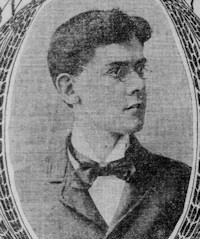the population of Cambodia was "toothless before [they] were 30 years old."
"The few [teeth] that were left he drilled and filled with gold and the vacant places he supplied with false molars and incisors."
(San Francisco Call, November 16, 1901)
In desperation, King Noradom, whose head "was tied up in a poultice to reduce swelling" had summoned Dr. Carrington, whose "feats of painless extraction" he had read about in Bangkok newspapers. The king himself had been educated in Bangkok. After his examination, Dr. Carrington immediately extracted the king's "aching teeth." The remaining were "drilled and filled with gold and the vacant places" were "supplied with [two sets of] false molars and incisors"-- one black and the other white. The king wore the white dentures when "in the company of white people, but when among his own race" he inserted the black ones.
The Cambodian people, along with natives of the tropical Pacific, Asia, and parts of East Africa, chew the betel nut -- a kind of national addiction of the time. It acts as a mild stimulant like coffee, although its use has declined somewhat over the years in urban areas. Over time, the nut (Areca catechu) dyes teeth black and destroys gums. One 20th century newspaper article claimed half
majesty's household in a state of great agitation." A London Times article of the era describes the palace as "a rambling pile of disjointed buildings of different shapes, scattered over a large enclosure, surrounded by a wall of brick and plaster." The king had a harem of 800 wives who had borne him 56 children.
Dr. Carrington found the king "irritable" and his servants "fearful of his wrath." Before the young American dentist arrived, French and Chinese dentists "had failed in their attempts to supply him with imitation teeth." One newspaper article revealed the French dentist had fitted him with false teeth that were held together with "a lot of springs," and when he talked, they either "bounded out of his mouth" or sometimes locked up and "held his jaws so he could not close them." The Chinese dentures were made of ivory from elephant tusks. They "wobbled so much that they gave the king a lantern-jawed aspect."
Apparently neither the French nor Chinese dentists had dealt with the king's underlying problem of diseased teeth.
Page 1
By Daniel Demers, DrBicuspid.com contributing writer
Continued Page 2
Courtesy of:
January 14, 2014 -- In 1901, Dr. Paul T. Carrington traveled 1,200 miles by steamboat from Bangkok to Phnom Penh following an urgent plea from Cambodian King Noradom I who was "suffering immensely from aching molars." The trip took the 25-year-old dentist five days.
Dr. Carrington had graduated from the University of California Dental College in 1897 and was practicing dentistry in Bangkok, Siam (now Thailand), where he had been born and raised by his Presbyterian missionary parents. His father, Rev. John Carrington, had gained worldwide fame for transcribing the Bible into Siamese. Dr. Carrington's patients included the ruling family of Siam, who were made famous in the 1944 novel Anna and the King of Siam, based on the memoirs of English governess Anna Leonowens and which later inspired the Broadway play and Hollywood movie "The King and I."
When Dr. Carrington arrived at the king's palace, he found "his
Dr. Paul Carrington and the king's teeth



Dr. Paul T. Carrington
E-MAIL ME ddemers901@sonic.net


